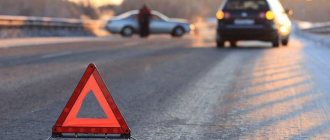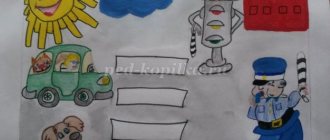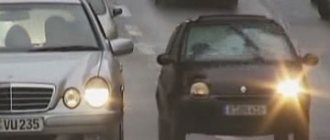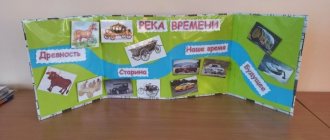Summary of a lesson-game on the rules of the road. Plan-summary of a lesson on life safety (grades 3, 4)
Municipal budgetary educational institution "School No. 8 for students with disabilities in the Lytkarino urban district, Moscow region"
Game lesson on traffic rules in elementary school
"Traffic Laws"
Spent:
primary school teacher
Koknaeva S.G.
April 2022
Lesson-game on traffic rules in elementary school “Road Rules”
Description of work: The lesson-game “Road Rules” is intended for children of primary school age (grades 3-4). Primary school teachers can use this development. The lesson-game can be used in extracurricular activities, in classes on traffic rules. Goal: developing the idea of primary schoolchildren about road safety. Objectives: - consolidate students’ knowledge about traffic regulation; — introduce the history of the emergence of traffic rules; — develop children’s ability to recognize road signs; - develop thinking, memory, attention; — cultivate a general culture of behavior on the street Equipment: — projector, computer, board; — presentation “Traffic Law”; — traffic rules posters; — split road signs “Brick”, “Pedestrian crossing”, “Pedestrian traffic is prohibited”, “Parking area”, Underpass”, “Bus and tram stop”, “Road works”, “Overtaking is prohibited”, “Slippery road” , “Railway crossing without a barrier”, “First aid station”, “Hospital”, “Gas station”; — quiz answer sheets; - rod; - traffic light; — certificates for awarding winners; - task cards
During the classes
1. Org. moment - Today we have an unusual lesson - a game. 4 teams from our class take part in the game, which will show their knowledge of the laws of streets and roads, and traffic rules. (The teams are being introduced.)
2. Setting lesson goals -Why do we need to know the rules of the road? (so as not to get hit by a car and die)
Crossword questions 1) What is another name for a pedestrian crossing? (zebra) 2) A person who regulates traffic at intersections and roads. (traffic controller) 3) The traffic controller's striped stick. (rod) 4) What is the name of any street or avenue used for traffic, including sidewalks and curbs? (road) 5) The intersection of roads and streets. (intersection) 6) How do cars illuminate the roads? (headlights) 7) One of the means of traffic control. (traffic light) At what traffic light is pedestrians and vehicles allowed to move? (green) 9) Part of the road intended for pedestrian traffic. (sidewalk) 10) Waiting area for a bus, trolleybus, tram. (stop) 11) How to call a car, bus, tram, trolleybus in one word? (transport) 12) A person who drives any transport. (driver)
(zebra) 2) A person who regulates traffic at intersections and roads. (traffic controller) 3) The traffic controller's striped stick. (rod) 4) What is the name of any street or avenue used for traffic, including sidewalks and curbs? (road) 5) The intersection of roads and streets. (intersection) 6) How do cars illuminate the roads? (headlights) 7) One of the means of traffic control. (traffic light) At what traffic light is pedestrians and vehicles allowed to move? (green) 9) Part of the road intended for pedestrian traffic. (sidewalk) 10) Waiting area for a bus, trolleybus, tram. (stop) 11) How to call a car, bus, tram, trolleybus in one word? (transport) 12) A person who drives any transport. (driver)
-So why is it necessary to know the rules of the road? (for our safety)
3. Updating knowledge - Who knows when and where the first traffic rules appeared? - It turns out that it was a long time ago. -There was a time when only riders on horses, chariots and horse-drawn carts rode the streets and roads. They could be considered the first vehicles. They drove as they pleased, and therefore often collided with each other. There were often clashes between people and horses, and between horses. After all, city streets in those days were usually narrow, and the roads were winding and bumpy. It became clear that it was necessary to streamline traffic on streets and roads, so rules were invented that made traffic convenient and safe. The first traffic rules appeared more than 2000 years ago.
4. Game-competition - I will make riddles about road signs, and after discussion as a team you will have to pick up the required sign.
The sign scares drivers and prohibits entry for cars! Don't try to rush past the brick! (no entry sign)
There is a land crossing here, people walk all day long. You, driver, don’t be sad, let the pedestrian pass! (sign "Pedestrian crossing")
No pedestrians walk here in rain or shine. The sign tells them one thing: “You are prohibited from walking!” (sign “Pedestrian traffic prohibited”)
If the driver gets out here, he parks the car here, so that the car he doesn’t need doesn’t bother anyone. (sign "Parking area")
Every pedestrian knows about the underground passage. It doesn't decorate the city, But it doesn't interfere with cars! ("Underground crossing")
At this point the pedestrian waits patiently for transport. He's tired of walking, he wants to become a passenger. (“Bus and tram stops”) (slide No. 28)
- Let's sum up the preliminary results.
5. Physical exercise - Let's play the game "Traffic Light" and relax. If I show the red circle, you stand silently. If the circle is yellow, clap your hands. And if it’s green, let’s go straight away.
6. Competition “Road Situations” - Each team receives a specific situation that may arise on the road. Team members discuss and present to us an action plan that will help deal with the problem. Problem #1: You were riding in the back seat of a car. After stopping the car on the roadway, you need to get out. What will you do? Problem No. 2. You are standing at a bus stop and waiting for the bus. The bus is delayed, and the number of passengers at the stop increases. And then the bus arrived. What are you going to do? Problem No. 3 While driving on the bus, a fire suddenly started. What will you do? Problem No. 4 You are crossing the road when the traffic light is green. And suddenly the green light blinked quickly and quickly and switched to yellow. What should you do: walk forward to the opposite side of the street or go back to the sidewalk? (students in teams discuss the situation and talk about their actions) - Let's summarize the preliminary results.
7. Summing up the lesson (children go to the board and read poetry) Adults and children know. It will be easier to live in the world, If without a doubt you know the rules of the movement.
If you break the rules and run a red light, you will get various injuries and end up in the hospital!
If the light is green, Walk boldly, don’t yawn! But be careful, don't forget about cars!
If there is an intersection nearby, Or just a turn, Be careful, teenager, Or just a pedestrian! (slide number 43)
Did you like our game?
Summary of the quest game on traffic rules “Friends know the rules, which means I know them too”
Bibliographic description:
Medvedeva, O. N. Summary of the quest game on traffic rules “Friends know the rules, which means I know them too” / O. N. Medvedeva, I. V. Matushkina. — Text: direct // Questions of preschool pedagogy. — 2022. — No. 3 (13). - pp. 73-75. — URL: https://moluch.ru/th/1/archive/92/3339/ (access date: 01/03/2022).
Goal: to consolidate knowledge of traffic rules in a playful way.
Tasks:
– consolidate knowledge about traffic rules; about safe behavior on city streets; on the purpose of some road signs; about reflective dressings (flickers); their purpose; ideas about dangers on the road, the need to know and follow traffic rules; knowledge of works of art in which transport is found;
– develop: attention, observation, logical thinking while completing tasks; children’s ability to master basic rules of safe behavior on the road;
– to instill in children the need to comply with the norms and rules of behavior on the street and in transport.
Equipment: road signs, scooters, a “Find the Difference” picture, pictures with puzzles, materials for creating an emblem, signs on the territory of the kindergarten.
Venue: kindergarten territory.
Participants: senior group students.
Time: spring-summer.
Preliminary work: familiarization with road signs, rules of conduct on the road, reading fiction on the topic.
Progress of the quest game
Music room room
Host: Hello, dear guests! We are glad to welcome you to kindergarten. The graduation party will soon take place, and our graduates will go to school. In order for them to feel confident on the streets of the city, and for their parents not to worry about them, today we invite you to repeat the rules of the road by completing the exciting quest game “Friends know the rules, which means I know them too.” A team of “Traffic Lights” students along with a teacher take part in our game. We invited a traffic police inspector to monitor the progress of the game, and he will be assisted by a senior kindergarten teacher and a music director.
Host: You have to go through a difficult path on which you must complete tasks. All tests are related to traffic rules. Each team will receive a route sheet on which all points along the route are marked. Please note that there are signs throughout the kindergarten to help you find the right place. Our assistants will meet you at each point. The task should be completed in the order in which they are marked on the route sheet. Having completed the task correctly on one point, the team receives one letter. Having passed all the points and collected all the letters, the team must return to the music room and form a word from the collected letters. The first team to pronounce the resulting word wins. So, I’ll ask the team commander to come and get the route sheet and write the team name on it.
The leader gives the team captain a route sheet
Host: We wish you success! So, go ahead!
Teams are sent to the territory of the kindergarten to complete tasks in accordance with the received route sheet
1 question and answer point. The team should answer the questions.
– Why do you need to know the rules of the road? (To avoid getting into a difficult situation on the road)
– Where is it safe for a pedestrian to cross the roadway? (at the pedestrian crossing)
– Who are pedestrians? (People who do not travel by transport)
– Which side of the sidewalk should pedestrians stay on? Why? (On the right side so that pedestrians do not collide)
– What is the traffic light for? (To regulate the movement of drivers and pedestrians)
– How many colors does a traffic light have and what colors are they? (three; red yellow, green)
– Where should I wait for the bus? (At the stop)
– What should you wear to become more visible on the road? (flicker)
– What is a “zebra”? (this is the name given to the image of stripes on the road that indicate a pedestrian crossing)
Point 2: “Be careful.” Here are two pictures in which you need to find the differences.
3 point “All kinds of signs are important.” Guess the riddle, find the corresponding road sign on the territory of the kindergarten, the teacher will help you take a photo near it, then you need to return to the point and show us the photo.
I want to ask about the sign
The sign is drawn like this:
Guys in the triangle
They are running somewhere as fast as they can.
(Careful children)
4th point “We are going, going, going” (Held in the motor town) Now each team member will demonstrate figure driving of a scooter.
There are cones placed in the motor city,
which need to be driven around on a scooter without hitting them.
5 point “I am noticeable.” Guys, what is a “flicker”? Where do you think reflectors should be placed on clothing?” (children's reasoning). On an adult, it is recommended to attach reflectors just above the knee, and on a child at hip level. Why do you think? (Children's answers). That's right, in these places they will be most visible in the light of the car's headlights.
The team is asked to draw a sketch of a reflective bandage
6 point “It used to be like this...” Connect the pictures from the envelope in pairs - a type of transport of the past and a type of present transport.
7 point “Remember and name.” Name three works of fiction in which vehicles (non-fictional) were mentioned.
K. Chukovsky “Cockroach”
G. Tsyferov “Locomotive from Romashkovo”
A. Pushkin. “The Tale of Tsar Saltan, of his glorious and mighty hero Prince Guidon Saltanovich, and of the beautiful Swan Princess.”
8th point “You will guess and you will find out.” Solve the suggested puzzles (road, car)
The team returns to the music room and puts the letters together to form a word.
Host: You have passed all the tests. Well done! Having correctly added the resulting letters, you get the word MOVEMENT.
Host: And now the floor is given to our guest - the traffic police inspector.
Summing up the results of the event, awarding teams and participants.
Traffic police inspector: We hope that all participants liked our quest game, and you remembered a lot about the rules of the road. Thank you for participating! We wish you success!
Literature:
- Journey through the Ocean of Books: methodological recommendations for municipal children's libraries on conducting quest games / BukOO "Library named after. M. M. Prishvina"; [comp. A. G. Nogotkova]. - Orel, 2013. - 36 p.
- What is a quest? [Electronic resource]: website // GuestsGuru.ru. — Access mode: https://questsguru.ru/quest-info.
- Riddle [Electronic resource]: https://club-edu.tambov.ru/vjpusk/vjp120/rabot/10/new_page_4.htm
Key terms
(automatically generated)
: kindergarten, traffic, route sheet, team, music hall, safe behavior, letter, pedestrian crossing, rule of conduct, city street.





